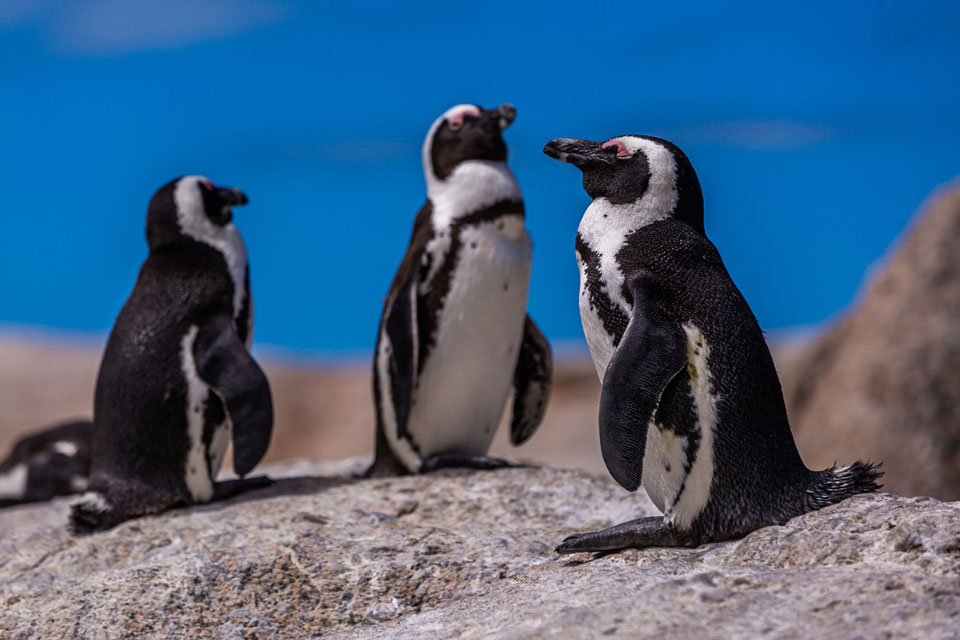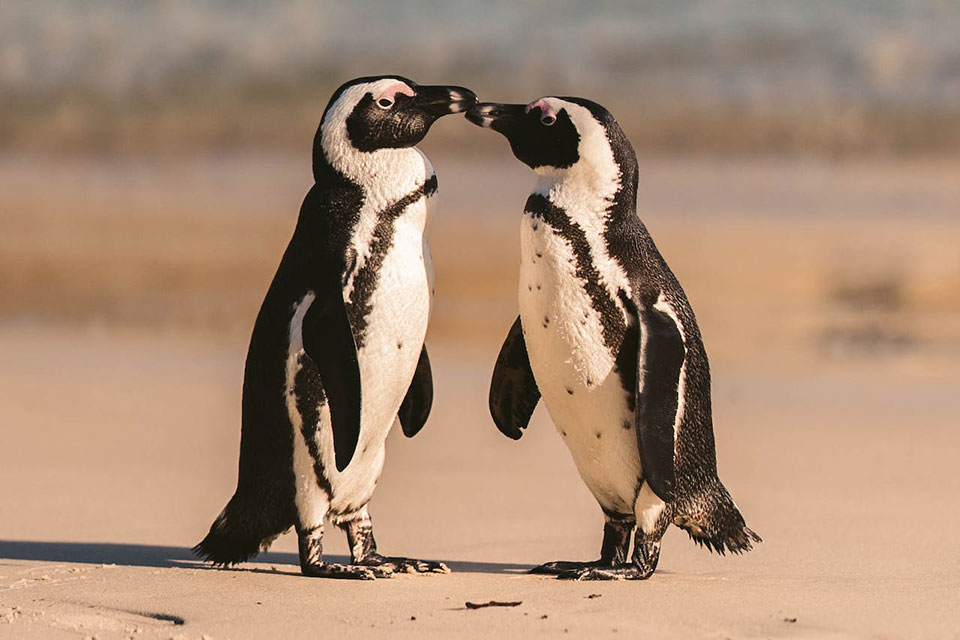When it comes to love, African penguins are quite unique. These fascinating birds form lifelong bonds with their mates, engaging in monogamous relationships that last a lifetime.
Let’s dive into the world of African penguin mating behavior and discover the secrets behind their enduring partnerships.
Key Takeaways:
- African penguins are monogamous birds that mate for life.
- They form long-term pair bonds and return to the same breeding colony and nesting site each year.
- If breeding fails, African penguins may take another partner.
- They engage in courtship rituals involving visual and auditory displays.
- Both parents share the responsibility of incubation and feeding their chicks.
African Penguin Breeding Cycle and Life Cycles
As we explore the fascinating world of African penguins, it’s important to understand their breeding cycle and life cycles. These monogamous birds breed throughout the year, returning to the same breeding colonies and nesting sites.
They typically form long-term pair bonds, but if breeding fails, they may take another partner.
Nesting is a crucial part of the African penguin breeding cycle. Previously, these penguins nested in layers of guano, but with the depletion of guano deposits, they have adapted to using alternate nesting places such as burrows, depressions under rocks, or man-made nests.
Breeding pairs excavate the nest and line it with various materials like seaweed, rocks, shells, and feathers.
With each breeding pair usually producing one to two eggs per clutch, both parents share the responsibility of incubation, taking turns to keep the eggs warm. The incubation period lasts 38-41 days, and the eggs do not hatch at the same time, usually hatching about two days apart.
Once the chicks hatch, they are brooded for the first 15 days and then become independent of parental care three months after hatching. It takes around four to six years for them to reach sexual maturity, and they can live up to 27 years in the wild.
The extended breeding cycle of African penguins allows them to continue breeding and sustaining their populations throughout the year, despite facing various threats to their survival.
African Penguin Physical Characteristics and Adaptations

African penguins possess unique physical characteristics and adaptations that enable them to thrive in their aquatic and terrestrial habitats. These flightless birds have a streamlined body, modified wings that function as flippers for efficient swimming, and black and white plumage.
They have a distinctive black back, white belly, and a thick black stripe curving across their chest and down the flanks. African penguins also have black webbed feet and a black facial mask with pink patches of skin above their eyes.
Their physical adaptations extend beyond their appearance. African penguins have a waterproof and insulating coat of overlapping feathers that helps them maintain their body temperature in the cold waters of the Atlantic and Indian Oceans where they live.
Their feathers also enable them to remain buoyant while swimming. These penguins are highly efficient swimmers, reaching speeds of up to 20 km/h and diving to depths of up to 130 meters to catch their prey.
On land, African penguins are clumsy walkers but can run quickly when necessary. They have physiological and behavioral adaptations to cope with both aquatic and terrestrial environments. For example, they spend most of their day at sea, returning to the breeding colonies to nest and raise their chicks.
To regulate their body temperature, African penguins seek shade and engage in behaviors like spreading their flippers to cool down. These adaptations allow them to adapt to the challenging conditions of their natural habitat.
Threats to African Penguins and Conservation Efforts
African penguins, despite their remarkable adaptations and unique behaviors, face significant threats that have contributed to a rapid decline in their population. One of the main challenges these penguins encounter is overexploitation for food.
The depletion of fish stocks due to commercial fishing has resulted in a scarcity of prey for the penguins. This competition for food resources can have detrimental effects on their overall health and reproductive success.
Habitat modification is another major threat to African penguins. The destruction and alteration of their nesting sites, such as the loss of guano deposits, have forced these birds to adapt to different nesting locations. This disruption can lead to a decrease in breeding success and the overall stability of their colonies.
Oil spills pose yet another danger to African penguins. These events can coat their feathers, impairing their buoyancy, insulating properties, and ability to regulate body temperature. The ingestion of oil while preening can also be lethal to these birds.
To address these threats and ensure the survival of African penguins, conservation efforts are underway. Protected areas have been established to safeguard their habitats, allowing for the recovery and growth of their populations.
Habitat restoration programs work to create suitable nesting sites and promote ecological balance.
Monitoring and research initiatives provide valuable data on population trends, behavior, and the impact of conservation measures. Public education campaigns raise awareness about the importance of conserving African penguins and inspire individuals to take action.
By implementing these conservation efforts, we can make a significant difference in the future of African penguins. It is crucial that we continue our collaborative efforts to protect these incredible birds, preserve their habitats, and ensure their survival for generations to come.
Conclusion
In conclusion, the African penguin is a remarkable species found in southern Africa, known for its distinctive appearance and fascinating mating behavior. These penguins mate for life, forming lifelong pair bonds and returning to the same breeding colonies and nesting sites each year.
They breed throughout the year, exhibiting an extended breeding cycle that allows them to raise their chicks effectively.
With their streamlined bodies, modified wings, and efficient swimming abilities, African penguins are well-adapted to their aquatic lifestyle. However, they also face numerous threats that have led to a significant decline in their population.
Overexploitation for food, habitat modification, oil spills, and competition for food with commercial fishing have all contributed to their endangered status.
To protect and restore African penguin populations, conservation efforts have been implemented. This includes the establishment of protected areas, habitat restoration projects, and ongoing monitoring and research programs.
Public education initiatives are also crucial in raising awareness about the importance of conserving these iconic birds.
If you’re visiting South Africa, be sure to make a stop at Boulders Beach. This popular tourist attraction is home to a resident African penguin colony, offering a unique opportunity to observe these incredible creatures up close.
By supporting conservation efforts and spreading the word about the importance of protecting African penguins, we can ensure their survival for future generations.
FAQ
Do African penguins mate for life?
Yes, African penguins are monogamous birds that breed with one partner for their entire life.
What is the breeding cycle of African penguins?
African penguins breed throughout the year, returning to the same breeding colonies and nesting sites. Each breeding pair usually produces one to two eggs per clutch.
How long does incubation last for African penguins?
Incubation for African penguins lasts around 38-41 days, and both parents share the responsibility of keeping the eggs warm.
What are the physical characteristics of African penguins?
African penguins have a distinctive black and white plumage, with a black back and white belly. They have a black facial mask with pink patches of skin above the eyes and a unique pattern of black spots on the chest.
What threats do African penguins face?
African penguins face threats such as overexploitation for food, habitat modification, oil spills, and competition for food with commercial fishing.
What conservation efforts are being made to protect African penguins?
Conservation efforts include the establishment of protected areas, habitat restoration, monitoring and research programs, and public education initiatives.


